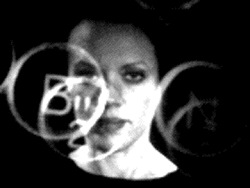Shaping the Profession (Chapters 4-6)
In the next section, three authors demonstrate how digital technology has shaped technical and professional communication and also composition instruction.
Jason Farman begins in the opening chapter (Chapter 4) by describing the creation of an interactive CD-ROM and its subsequent translation to an interactive DVD.
 Where Where There There Where by Zoe Beloff and the Wooster Group 1998, CD-ROM.
Where Where There There Where by Zoe Beloff and the Wooster Group 1998, CD-ROM.Visit the Electronic Arts Intermix website for more details. Visit the interactive site to explore.
This recorded performance of a Gertrude Stein play demonstrates genre and media mixing and creates new media interactivity. This interactivity forms "a sense of agency" that is a fictive mediation between user and technology (p. 88). This case study demonstrates how new media mediates a relationship between users and digital documents, but this chapter seems to be the most difficult to place in the overall theme of the collection. While it does demonstrate the kind of complex relationship Lamberti and Richards describe between users and designers, Farman’s examination does not quite fit the divergence theme, and for this reason, it seems out of place at times. Perhaps his piece is meant to augment more particularly the user/designer binary that the editors introduce.
In the next chapter (Chapter 5), John B. Killoran describes the cultural capital of web portfolios, concluding that only some groups would find these cultural artifacts relevant and valuable. By demonstrating this, Killoran enjoins the digital divergence the editors describe. Grounding his notions in Pierre Bourdieu's (1986) work, he describes particularly "our noneconomic wealth in forms such as knowledge, skills, and educational degrees" (p. 96). Killoran collects a sample of self-published web resumes to determine the correlations between the self-publications and occupational distribution. He describes pedagogical implications of his study of web portfolios to suggest that teachers should ask students to critically reflect on the role portfolios play as cultural capital and also on the employment market itself. By describing this reflection process, he foregrounds those groups who would find digitized cultural capital useful and those who would not.
Huiling Ding studies the Writing Program Administrators (WPA) email list (in Chapter 6), and she concludes that such lists have served to enhance the cultural and professional perception of writing program administrators, giving them a place to share formal and informal knowledge, produce new knowledge, mentor new members of the composition community, and archive this knowledge. 
If you haven't already, follow the directions to join the WPA-L mailing list.Ding suggests that WPA Council reach out to the "larger community of compositionists," like those interested in professional writing and digital composition. But it is not clear why she says that the WPA-L list "ultimately fails" in assisting those interested in such adjacent disciplines (p. 127). Perhaps this is the kind of "tacit knowledge" (p. 123) that technical and professional communicators hold as a common experience using the WPA list, but her claims seems unsupported as they stand in those final sections of the analysis. Perhaps an alternate study could show how disciplinary email lists either diminish or distinguish boundaries among the writing studies community.

